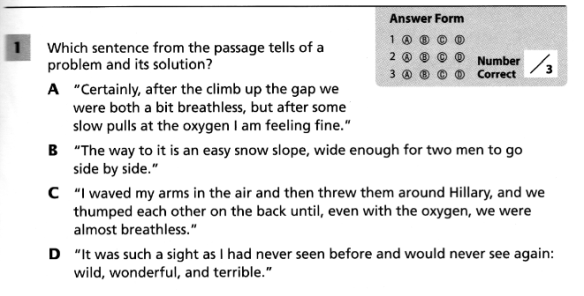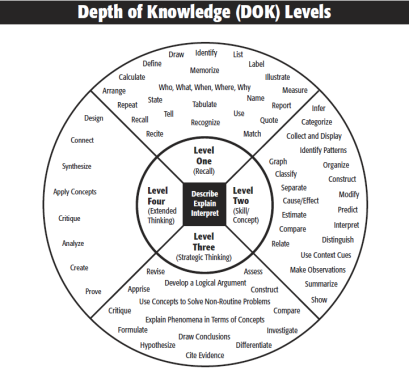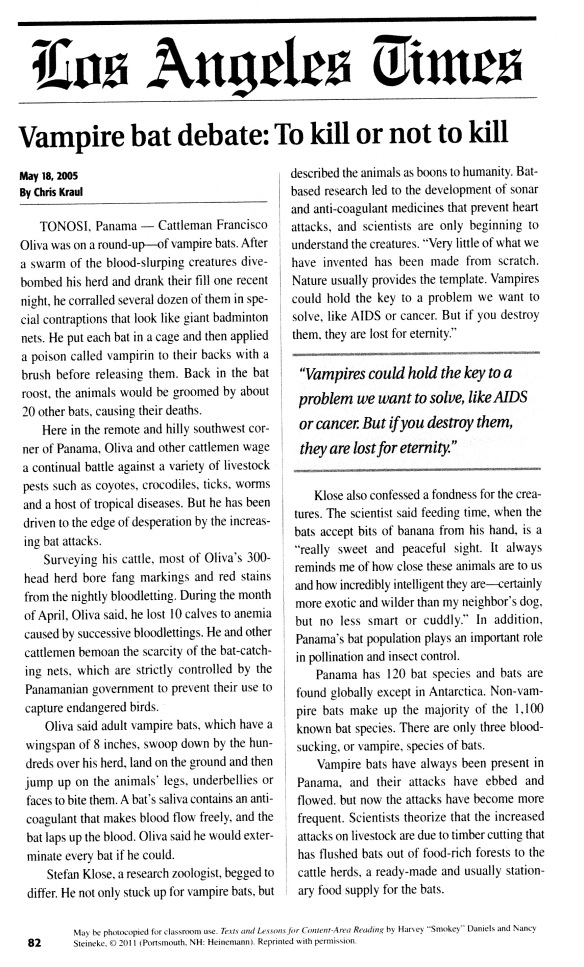
From edrethink, http://www.educationrethink.com
After an amazing weekend at the Dublin Literacy Conference, which was all about real reading and writing, I arrived back home to find many schools plunging into test prep. The New York State tests aren’t until April, but many schools are already worried about this year’s ELA test, which supposedly has been aligned to the Standards. The New York City Schools Chancellor has already said that he expects scores to plummet, and the sample tests the state has posted on their engageny website have done nothing to allay fears. Third graders are expected to read a story by Tolstoy, which a parent of a city third grader called “excruciatingly dull and confusing.” And fifth graders are asked to compare two passages written from an animal’s point of view—one from The Secret Garden, the other from Black Beauty—and discuss how “the animal’s perspectives influence how events are described.”
Given that teachers are being evaluated by test scores in New York and other states, the apprehension seems justified. And so the test prep workbooks have come out. These workbooks, too, have supposedly been aligned to the Common Core, and at least in the ones I’ve seen, a whole new crop of questions are being asked about the text structure of nonfiction texts in order to assess whether students are meeting Reading Informational Texts Standard 5. These include questions not just about the structure of the entire passage, but also the structure of individual paragraphs and sentences, as can be seen below.
Here, for instance, is a 4th grade text-structure question about an article on the history of film making:

And here is another on an excerpt from the autobiography of one of the first climbers to reach the top of Mount Everest:

 Each of these questions ask students to identify or match a sentence with a text structure type, which, in terms of Webb’s Depth of Knowledge, is only Level 1 thinking. Each can also be answered without actually reading the passage, which surely is not what the Standards intended. And all this has led to a new crop of test-taking strategies being taught—such as looking for text-structure signal words—which, in turn, is taking time away from authentic reading.
Each of these questions ask students to identify or match a sentence with a text structure type, which, in terms of Webb’s Depth of Knowledge, is only Level 1 thinking. Each can also be answered without actually reading the passage, which surely is not what the Standards intended. And all this has led to a new crop of test-taking strategies being taught—such as looking for text-structure signal words—which, in turn, is taking time away from authentic reading.
Ironically, these text-structure questions also fly in the face of some of the pronouncements of David Coleman, chief architect of the Common Core. I rarely agree with Coleman’s solutions to the problems he sees in classrooms, especially when it comes to overly prompted models of close reading, but I often agree with his diagnoses. Here, for instance, in a presentation he gave to the New York State Department of Education, he comes down hard on what he calls “the strategy of the week”—i.e., using texts to practice a skill or strategy, such as identifying cause and effect—which I, too, believe is problematic in the way he describes:
“Nothing could be more lethal to paying attention to the text in front of you than such a hunt and seek mission. . . . When have you read a difficult text ever in your life and said, ‘I’ve got it now. It’s a cause and effect text not a problem and solution text.’ We lavish too much attention on these strategies in the place of reading. I would urge us to instead read.”
But all this does raise the question: Does knowing about concepts such as cause and effect, problem and solution and compare and contrast actually help us, as authentic readers, understand what an author of a nonfiction text might be trying to say? I think it can, but not as reflected in the above kind of questions. To see how, let’s look at one of the ‘one-page wonders’ Harvey Daniels and Nancy Steineke share in their great resource Text Lessons for Content-Area Reading: “Vampire Bat Debate: To Kill or Not to Kill” by Chris Kraul.

If identification is the name of the game, the title alone lets us know that this is a compare-and-contrast piece. But if we want to truly understand the complexity of the debate, not just identify the text-structure, we need to remember what we instinctively know as readers: that nonfiction authors frequently explore problems and solutions, causes and effects, and different perspectives in the pieces they write. And so as readers, we enter the text on the look out not only for the different points of view alluded to in the title but for the problems that sparked the debate, the causes and effects of those problems, and the real and possible effects of whatever solutions have been undertaken or proposed.
 In this way, we use our understanding of those concepts to dig deeper into the text; they expand our understanding, rather than reduce it, which happens when we try to fit a text that explores virtually anything complicated into a text-structure vise. And so beyond test prep, I don’t spend a lot of time explicitly teaching text structures. Instead, with the vampire bat article, I’ve been asking students to consider how each paragraph adds to their understanding of the title’s debate and how each is connected to the next. This has allowed them to construct their understanding of the complexity of the issue as they make their way through the text—and for problem and solution and cause and effect to rise up naturally as they read and discuss it, not because I’ve sent them on a hunt and seek mission.
In this way, we use our understanding of those concepts to dig deeper into the text; they expand our understanding, rather than reduce it, which happens when we try to fit a text that explores virtually anything complicated into a text-structure vise. And so beyond test prep, I don’t spend a lot of time explicitly teaching text structures. Instead, with the vampire bat article, I’ve been asking students to consider how each paragraph adds to their understanding of the title’s debate and how each is connected to the next. This has allowed them to construct their understanding of the complexity of the issue as they make their way through the text—and for problem and solution and cause and effect to rise up naturally as they read and discuss it, not because I’ve sent them on a hunt and seek mission.
I’ve also been asking students whether they think the author has an opinion, and many have said that they think he does—that he sides with the scientists, not the cattlemen, because he devotes more words and space to the scientists’ side and lets them have the last word. That seems a far more insightful analysis of the text’s structure than anything the workbook questions ask for. And it involves much higher levels of thinking than those multiple choice questions demand.
 I truly believe that this kind of real reading can ultimately prepare students for the test as well as any short-cut strategies, such as hunting for signal words, can. And it produces none of the negative effects—the narrowing of curriculum, the stressful climate in classrooms, and the lack of critical thinking—that a coalition of Massachusetts college professors recently cited as reasons why their state should abandon high-stakes standardized testing. And so I find myself in the surprising position of echoing David Coleman: Let’s try as much as humanly possible to keep it real by really reading.
I truly believe that this kind of real reading can ultimately prepare students for the test as well as any short-cut strategies, such as hunting for signal words, can. And it produces none of the negative effects—the narrowing of curriculum, the stressful climate in classrooms, and the lack of critical thinking—that a coalition of Massachusetts college professors recently cited as reasons why their state should abandon high-stakes standardized testing. And so I find myself in the surprising position of echoing David Coleman: Let’s try as much as humanly possible to keep it real by really reading.

Terrific! Thanks for encouraging us to think!
I’m writing to ask two spelling questions.
(1) Did Coleman say “caught and effect” or is that a typo? (2) The text says “vice”, but the picture shows a vise.
Oh, how embarrassing! I was rushing to get this out before a busy work week started, and you caught me in a spelling vice! Thanks!
And here’s my specific question — is the Harvey Daniels and Nancy Steineke resource worth the $32 for a 5th grade LA teacher? Any other really great resources for short fiction passages?
Also — love that question, “Does the author have an opinion?”
I think the Daniels book depends on how much you want—or feel compelled to—push kids outside of their comfort zone. The NYS test prep material has articles from the NY Times for the 4th grade, and some of the pieces in the Daniels book would be suitable. But overall I do tend to think it’s more for middle and high school. (I did, though, adapt the Vampire piece for 4th grade and I can email you a copy if you like.) In terms of short fiction, I don’t really know of one, which is why I’ve been considering compiling and writing something like that myself. Will keep you posted on that project. And in the meantime, I’m really looking forward to seeing you in San Antonio!
I would LOVE you to write/compile that book!!! And I would love a copy of the Vampire piece, please.
I rely pretty heavily on Highlights Magazine for short texts (F/NF) right now. Sounds like I can save my $60 on the two Daniels books (he’s coming out with a fiction one, I see on Amazon). Thanks for the answer! See you in San Antonio!
Yes, would you please send me a copy of the article on vampire bats. Your blog about text structures was just what I needed.
On its way to you now . . .
Pingback: Really Reading in Test Prep Season | Striving Higher
Hi,
Read this one yesterday or Fri. Could not decide on the correct answer for the first multiple choice question. Felt dumb (was not feeling well, partly a defense). Pondered a bit and went back and have decided it is “B”. Hope I am correct. Help! Anyhow I was putting myself in the position of a typical 4th grader. Really????
Anyhow see you in San Antonio! Also if Mary Lee hasn’t mentioned it I hope you know that March Madness Poetry at Think Kid Think dot com is starting tomorrow. If you have not read about it or do not know about it a quick trip to Ed’s site will fill you in! I adored this last year and Mary Lee, a wonderful poet, made it to the elite eight with some fabulous poems and only lost by 1 vote! I highly recommend this for literacy gold-mining!
P.S. The answer was B. These questions are totally tripping students up this year, but I have to imagine that we’ll come up with all kind of short-cut strategies and tricks for them to use next year if the tests continue to determine curriculum. But for now I want to step away from that and check out March Madness Poetry!
I teach text structure in middle school, as a text-attack strategy. This is truly for my struggling readers to help them begin to read a text knowing what to expect. The texts I am referring to are not one-line sentences like above. I can appreciate David Coleman’s stance – instead of having students focus on “filling in the blanks,” to just have them read. I would be the first teacher to say our students need to just read, read, and read more. However, exposing students to the facts that texts do actually fall into a type of frame is adding more comprehension power to their building-meaning capabilities.
I agree completely that when we, as experienced readers, come to a nonfiction text we bring with us an understanding that writers may not just be giving us facts but exploring ideas that frequently involve cause and effect, problems and solutions, and comparisons. And knowing that, we’re on the look-out for those ideas in an active, albeit sometimes unconscious, way. So I definitely see how introducing those structures as a strategy can be really useful. What’s important I think is seeing them as a means to dig deeper into the text, not just to the end of identifying, which I fear is what the tests emphasize–and what we can aim our teaching at if we feel pressure to teach to the test, rather than teach beyond it.
Pingback: Is Test Prep the Mint of Education? | Reading to the Core
Pingback: What’s the Main Idea of the Main Idea? | To Make a Prairie